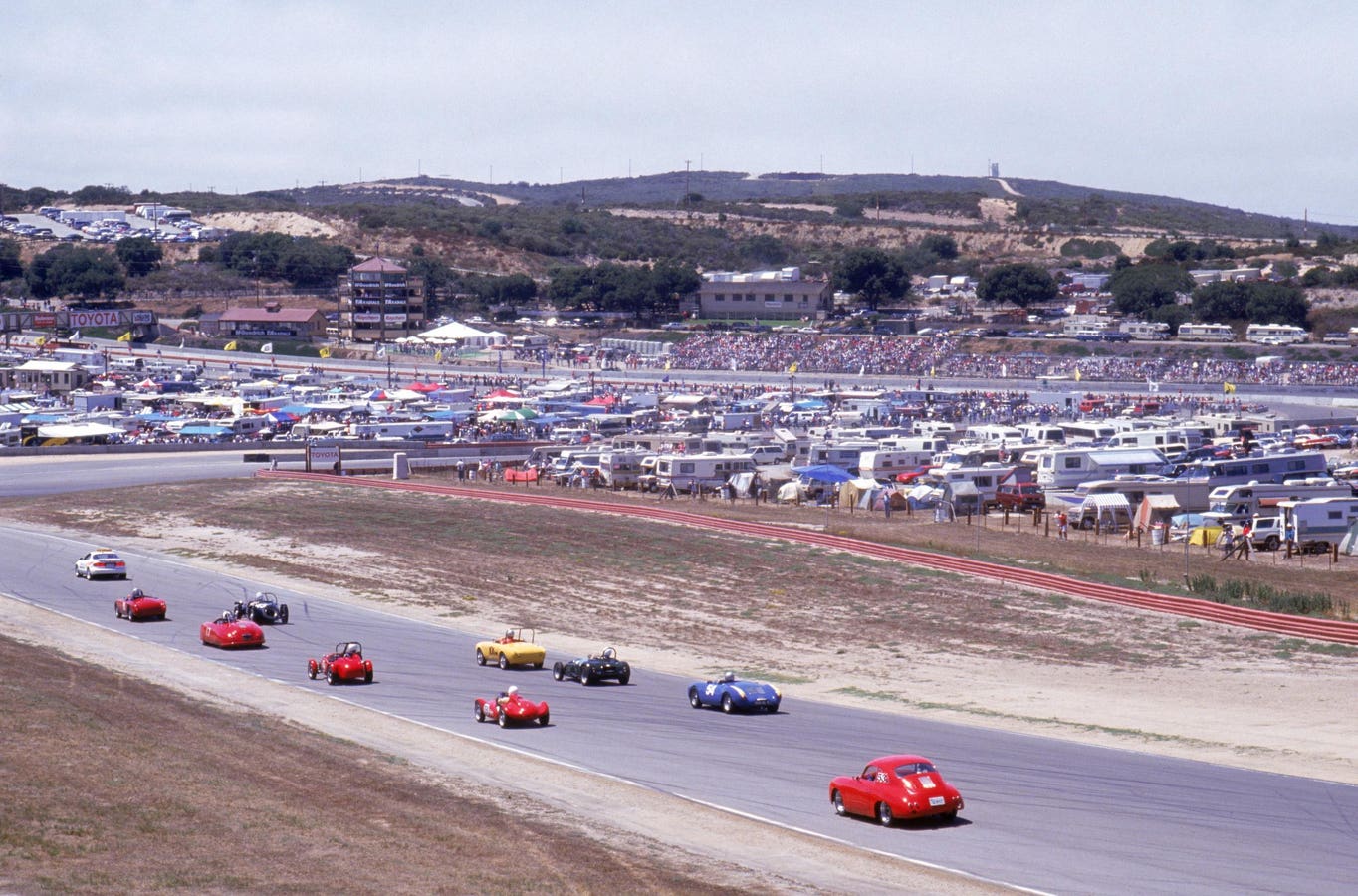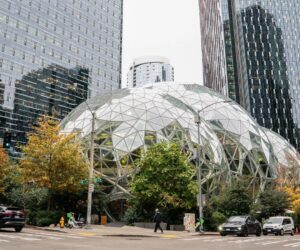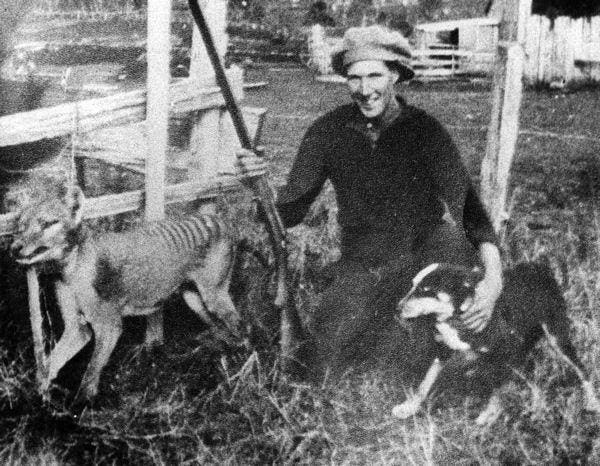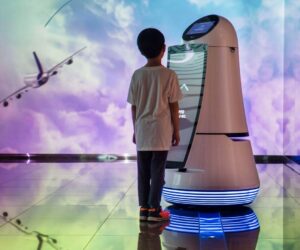MONTEREY, CA – 1991: General view as vintage autos drive on the track at Laguna Seca Raceway during the Monterey Historic Automobile Races in Monterey, California. (Photo by Stephen Dunn)
Getty Images
IAC (Indy Autonomous Challenge) robotic race cars performed at the historic WeatherTech Raceway Laguna Seca in Monterey, CA on July 24, 2025. Eight teams participated in individual time trials across a challenging track (~2.25 miles/lap) with 11 sharp turns (including the famous corkscrew, see Figure 1 below), and steep elevation changes (180 feet). This is a first for robotic racing in the history of the WeatherTech Raceway. It is also the first time that IAC has performed during a week of Indy 500 racing events, culminating on 27 July 2025 with the Java House Grand Prix race.
Figure 1: SALINAS, CA – Fans watch on the hill at the NTT IndyCar Series Firestone Grand Prix of Monterey on June 23, 2024 at WeatherTech Raceway Laguna Seca in Salinas, CA. (Photo by Larry Placido)
Icon Sportswire via Getty Images
IAC has been hosting robotic car races since 2021 at tracks like the Indiana Motor Speedway (home of the Indy 500) and the Las Vegas Motor Speedway. The event in Las Vegas, held in concert with the Consumer Electronics Show (CES) in January 2025, featured a 4-car race, something not attempted before. At the recent event in Monterey (the first time an IAC event was held during the same time period and track as the Indy 500 race), the competition featured single race cars at a time. Given the difficulty of the track and first-time participation by the different teams, multi-car racing was considered to be too risky. The course is particularly challenging for robotic cars given the perception and localization challenges due to the sharp turns and elevation changes. Stable vehicle control at high speeds is also difficult because of these factors.
IAC event competitors include university teams (typically with Ph.D. level students and faculty advisors) from the USA, Germany, Italy and Korea. Participating teams for this event included:
- Cavalier Autonomous Racing (University of Virginia)
- PoliMOVE-MSU (Collaboration between Politecnico di Milano, Italy, Michigan State University and University of Alabama)
- KAIST (Korea Advanced Institute of Science and Technology)
- Autonomous Tiger Racing (Auburn University)
- Purdue AI Racing (Purdue University)
- AI Racing Tech (Universities of California at Berkeley and San Diego, Hawaii and Carnegie Mellon)
- IU LUDDY (Indiana University)
- CAST Racer (California Institute of Technology)
IAC Race Results at Laguna Seca, Monterey
IAC races are designed to engage top robotics, artificial intelligence (AI) and vehicle dynamics/control talent across universities. The goal is to nurture practical experience in physical AI, and use the intellectual property to understand autonomy in high speed, commercial applications like autonomous cars and drones. The hardware platforms are identical (car, engines, tires, sensors, compute). Teams compete based on the quality of the AI and robotic control at high speeds, and low latency perception and decision making,
PolyMOVE-MSU won the event with a winning lap time of ~90 seconds over the 2.25-mile course (average speed of ~90 mph). The peak speed reached was 148 mph. This is the first ever experience for an autonomous racing competition on a road-course circuit in the USA (Figure 2). The Purdue team was a strong competitor and came in second, with KAIST in third place. A couple of cars (CAST-Caltech and Tiger Racing) were unable to negotiate the difficult corkscrew turn and had to be rescued by tow trucks (human driven! We are yet to get to autonomous tow trucks !).
Figure 2: POLIMOVE-MSU Wins at Laguna Seca
POLIMOVE & IAC
According to Paul Mitchell, CEO of Indy Autonomous Challenge and its parent company Aidoptation: “Our university research teams stepped up to this challenge, advancing the field of AI and autonomy by pushing vehicle dynamics to the absolute edge and laying down lap times that only the best human drivers can achieve”.
Professor Sergio Savaresi (Polytecnico Di Milano) and Rodrigo Senofieni (former Ph.D. student of Professor Savaresi, and currently at Aidoptation) are the technical leads for the PoliMOVE-MSU team. Per Professor Savaresi, the key enablers for their winning performance were:
- Pre-competition Preparation: compared to oval track racing like in Indianapolis and Las Vegas, road tracks like Laguna Seca are especially challenging because of the elevation changes and sharp turns. Longitudinal vehicle dynamics is a critical consideration (frequent braking and accelerating) in this case. The PolyMOVE-MSU team performed extensive simulations to develop this capability, designing a physics-based longitudinal dynamics model and control algorithm, and a simulation-based trajectory aimed at achieving a lap time of 127 second (achieved 129 seconds in the race). Factors like slippage during acceleration and distance prediction and instability during braking (with real-time data on track and tire conditions) were considered. LiDAR (Light Detection and Ranging) based localization was the other key technology block that was developed. As opposed to oval tracks, GPS sensors do not work consistently and accurately on road tracks like Laguna Seca, and developing an AI-based module to do this was a key pre-competition activity.
- Competition Tactics: Since the competition involved only individual time trials, the order in which teams perform matters greatly. PolyMOVE-MSU went after Purdue, and knew the latter’s performance (~130 sec/lap) before they started. The team decided to hit the 129 second/lap target, even though they had planned to hit 127 seconds. This was a matter of balancing mission risk and achieving the victory.
- What Does it Take to Have Multi-Car, Head-Head Racing on Road Tracks? Prior IAC events in Indianapolis and Las Vegas had multi-car racing on oval tracks. For road tracks, two additional capabilities are required. The first is advanced perception that tracks opponent cars at every moment in time, and also predicts their trajectory. In addition to global path planning which emphasizes optimal trajectory design, local planning which constantly uses perception information to make real-time tactical decisions is the other required capability. Both these capabilities can use real and simulated data to train AI modules.
Professor Savaresi commented: “Our team spent a lot of time in simulation to perfect the AI driver’s decision-making capabilities. I am incredibly proud of this team”.
Purdue entered the IAC in 2021, but decided to reorganize 18 months ago to grow capabilities and focus. IAC provided guidance and sharing of best practices, and Purdue’s Dean of Engineering, Arvind Raman internally championed the initiative. Dan Williams, an ex-automotive executive with extensive experience in vehicle autonomy joined as Professor of Practice two years ago, and allocates ~50 % of his time in mentoring the team of graduate students from diverse disciplines like vehicle dynamics and computer science. As a result, Purdue was just a second behind the seasoned winner PolyMOVE-MSU, a remarkable achievement on this complex racecourse. Per Professor Williams, the factors that contributed to this are:
- IAC guidance and support from Purdue University administration with stable funding, and faculty involvement from diverse engineering disciplines
- Creating a team structure that nurtured student leadership
- Focusing team talent on balancing the physics of moving things (vehicle dynamics and control) and computer science (coding, machine learning, perception, localization).
It turns out that the complexity of the Laguna Seca roadway was a perfect fit for what Purdue had been training on under Professor William’s guidance for the past 12 months.
Java House Grand Prix of Monterey
Figure 3: SALINAS, CA – JULY 27, 2025: Cars round Turn 2 for the start of the Java House Grand Prix of Monterey at WeatherTech Raceway Laguna Seca in Salinas, CA. (Photo by Larry Placido)
Icon Sportswire via Getty Images
The Grand Prix event was held 3 days after the IAC robotic car race (24th July), on the same track (Figure 3). This is a Indy 500 racing circuit event consisting of 95 laps (~2.25 miles each) and 27 human-driven race cars, and is part of the NTT INDYCAR Series championship. Experiencing the throb, sounds, smells and sight of engine power equivalent to ~20,000 horses at the start of the race is an out-of-world experience!
The winner was Alex Palou, a strong favorite, driving the DHL Chip Ganassi Racing Honda race car (Figure 4).
Figure 4: SALINAS, CALIFORNIA – JULY 27: #10: Alex Palou, Chip Ganassi Racing Honda, Podium during the NTT INDYCAR Series Java House Grand Prix of Monterey at WeatherTech Raceway Laguna Seca on July 27, 2025. (Photo by Brandon Badraoui)
Lumen via Getty Images
The previous two days included trial competitions. Mr. Palou dominated here as well, and started in the leading position at the Grand Prix event. This is his third win in the past 4 years at this track. Including three pit stops, he took ~2 hours and 5 minutes to cover the 95 laps (~214 miles) at an average speed of 102 mph and reached a maximum average lap speed of ~114 mph in the 10th lap. For reference, Indy racecars can reach maximum speeds of ~240 mph on level, oval tracks like the Indiana Motor Speedway (IMS) in Indianapolis. Given the complexity of the Laguna Seca track, this is considerably lower (~50%).
Figure 5: SALINAS, CALIFORNIA – JULY 27: #10: Alex Palou, Chip Ganassi Racing Honda, #7: Christian Lundgaard, Arrow McLaren Chevrolet, #26: Colton Herta, Andretti Global w/ Curb-Agajanian Honda on the podium during the NTT INDYCAR Series Java House Grand Prix of Monterey at WeatherTech Raceway Laguna Seca (Photo by Michael L. Levitt/Lumen via Getty Images)
Lumen via Getty Images
Second and third place went to Arrow McLaren’s Christian Lundgaard and Colton Herta of Andretti Global (Figure 5). Lundgaard edged out Herta in an exciting finish in the track’s final corner. There were also a few collisions and crashes, and tense moments as officials scrambled to throw flags and clear accidents.
Following the Grand Prix event trials a day earlier, and seconds after Alex Palou exited the track, the PoliMOVE-MSU AI driver performed high speed autonomous laps for 10 minutes, exposing thousands of racing fans to the promise of robotic car racing.
The Fusion of Robotic and Human Driven Racecars
As mentioned earlier, the PolyMOVE-MSU team won the IAC robotic car event with an average lap time of 90 mph. This is about 80% of that achieved by Mr. Palou. The IAC race was substantially shorter (8 laps), raced a single car at a time., and had a few instances of hardware failures and crashes. Since only a single car performs at any given time, there are no risks of human fatality, multi-car collisions or extensive property damage. IAC racecars have achieved maximum speeds of ~150 mph on the IMS, about 60% that achieved by the Indy 500 cars. Part of the difference can be attributed to the more powerful engine in the latter (700 hp and 6 cylinder engine in the Indy 500 car vs 500 hp, 4 cylinder engine in the IAC car).
For Mel Harder, president & general manager, WeatherTech Raceway “Hosting the IAC at WeatherTech Raceway Laguna Seca as part of the Java House Grand Prix of Monterey was a thrill. Not only did we introduce our fans to the world’s fastest autonomous race cars, but IAC also attracted hundreds of companies, researchers, and government leaders in AI and autonomy from Silicon Valley and around the world to our venue, and promoted engagement in motorsports.”
Advances in sensing, perception and computing has enabled high-speed F-22 fighter jet pilots achieve substantially higher levels of speed (> Mach 2) and endurance. Similarly, progress in IAC technology (like sensors, perception, compute, vehicle dynamics and active safety) can enable human-driven race cars to achieve higher performance levels, balancing motorsport excitement, audience engagement and human safety. Learning from human race car drivers about multi-agent path planning (local planning) is absolutely critical for physical AI applications like AVs at very high speeds on highways. The ability to use visual, acoustic and localization cues that human drivers employ to operate in multi-agent environments is something that physical AI needs to emulate, on public roadways and racetracks.
The Future
Human-driven race car performance has plateaued over the last 50 years, because of passive safety protocol constraints and saturation of human driver capability at the top levels of performance. Of course, records will continue to be broken due to factors like weather and performance peaks, as well as changes in car design and race rules. But these improvements are likely to be limited and random.
For AI driven race cars, it is a different story. The technology is currently in its infancy, with significant opportunities for improvement as sensor hardware, software, compute stacks and digital twin simulation capabilities accelerate in performance. IAC car performance has improved orders of magnitude in the past 3 years of its existence. The Purdue team demonstrates how experience, physics and physical AI can improve performance dramatically in the space of 12 months. The question is whether Physical AI will improve to the point where robotic and human driven race cars are able to perform together in multi-car track or road racing?
To make this a reality, addressing the multi-agent path planning problem is critical. Human drivers are exceptional at this, robotic cars not so much. The success of road traffic applications in which Waymo autonomous cars and human-driven cars perform together in uncontrolled environments depends on humans and computers understanding each other’s cues, tactics and behavior (Figure 6).
Figure 6: Waymo self-driving car stopped at a traffic light on 2nd Street with adjacent vehicles and a commercial truck displaying grocery products, San Francisco, California, August 20, 2024
Gado via Getty Images
Mixed human and robotic racing will need similar understanding, but at extremely high speeds and very low decision-making latency. Human race car drivers can be instrumental in teaching AI drivers to solve this problem, not by massive data gathering and training, but maybe with other physical AI approaches like neuromorphic learning. Paul Mitchell, CEO of IAC “hopes that such performance parity and understanding will be achieved in the next 2 decades as IAC and motorsports nurture and learn from each other”.









